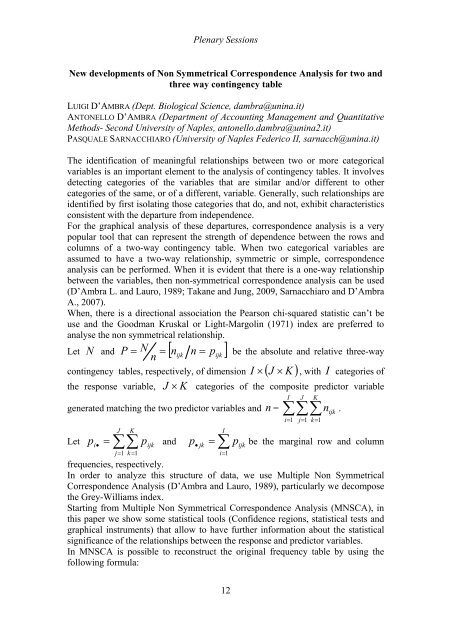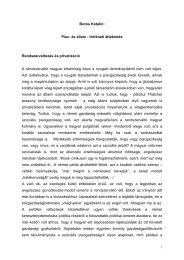Challenges for Analysis of the Economy, the Businesses, and Social ...
Challenges for Analysis of the Economy, the Businesses, and Social ...
Challenges for Analysis of the Economy, the Businesses, and Social ...
You also want an ePaper? Increase the reach of your titles
YUMPU automatically turns print PDFs into web optimized ePapers that Google loves.
Plenary Sessions<br />
New developments <strong>of</strong> Non Symmetrical Correspondence <strong>Analysis</strong> <strong>for</strong> two <strong>and</strong><br />
three way contingency table<br />
LUIGI D’AMBRA (Dept. Biological Science, dambra@unina.it)<br />
ANTONELLO D’AMBRA (Department <strong>of</strong> Accounting Management <strong>and</strong> Quantitative<br />
Methods- Second University <strong>of</strong> Naples, antonello.dambra@unina2.it)<br />
PASQUALE SARNACCHIARO (University <strong>of</strong> Naples Federico II, sarnacch@unina.it)<br />
The identification <strong>of</strong> meaningful relationships between two or more categorical<br />
variables is an important element to <strong>the</strong> analysis <strong>of</strong> contingency tables. It involves<br />
detecting categories <strong>of</strong> <strong>the</strong> variables that are similar <strong>and</strong>/or different to o<strong>the</strong>r<br />
categories <strong>of</strong> <strong>the</strong> same, or <strong>of</strong> a different, variable. Generally, such relationships are<br />
identified by first isolating those categories that do, <strong>and</strong> not, exhibit characteristics<br />
consistent with <strong>the</strong> departure from independence.<br />
For <strong>the</strong> graphical analysis <strong>of</strong> <strong>the</strong>se departures, correspondence analysis is a very<br />
popular tool that can represent <strong>the</strong> strength <strong>of</strong> dependence between <strong>the</strong> rows <strong>and</strong><br />
columns <strong>of</strong> a two-way contingency table. When two categorical variables are<br />
assumed to have a two-way relationship, symmetric or simple, correspondence<br />
analysis can be per<strong>for</strong>med. When it is evident that <strong>the</strong>re is a one-way relationship<br />
between <strong>the</strong> variables, <strong>the</strong>n non-symmetrical correspondence analysis can be used<br />
(D’Ambra L. <strong>and</strong> Lauro, 1989; Takane <strong>and</strong> Jung, 2009, Sarnacchiaro <strong>and</strong> D’Ambra<br />
A., 2007).<br />
When, <strong>the</strong>re is a directional association <strong>the</strong> Pearson chi-squared statistic can’t be<br />
use <strong>and</strong> <strong>the</strong> Goodman Kruskal or Light-Margolin (1971) index are preferred to<br />
analyse <strong>the</strong> non symmetrical relationship.<br />
Let N <strong>and</strong> P = N = [ nijk<br />
n = pijk<br />
] be <strong>the</strong> absolute <strong>and</strong> relative three-way<br />
n<br />
contingency tables, respectively, <strong>of</strong> dimension I × ( J × K ) , with I categories <strong>of</strong><br />
<strong>the</strong> response variable, J × K categories <strong>of</strong> <strong>the</strong> composite predictor variable<br />
I J K<br />
generated matching <strong>the</strong> two predictor variables <strong>and</strong> n = ∑∑∑nijk<br />
.<br />
J<br />
K<br />
I<br />
12<br />
i=<br />
1 j=<br />
1 k=<br />
1<br />
Let • ∑∑<br />
= =<br />
= pi<br />
pijk<br />
<strong>and</strong> p•<br />
jk = ∑ pijk<br />
be <strong>the</strong> marginal row <strong>and</strong> column<br />
j 1 k 1<br />
i=<br />
1<br />
frequencies, respectively.<br />
In order to analyze this structure <strong>of</strong> data, we use Multiple Non Symmetrical<br />
Correspondence <strong>Analysis</strong> (D’Ambra <strong>and</strong> Lauro, 1989), particularly we decompose<br />
<strong>the</strong> Grey-Williams index.<br />
Starting from Multiple Non Symmetrical Correspondence <strong>Analysis</strong> (MNSCA), in<br />
this paper we show some statistical tools (Confidence regions, statistical tests <strong>and</strong><br />
graphical instruments) that allow to have fur<strong>the</strong>r in<strong>for</strong>mation about <strong>the</strong> statistical<br />
significance <strong>of</strong> <strong>the</strong> relationships between <strong>the</strong> response <strong>and</strong> predictor variables.<br />
In MNSCA is possible to reconstruct <strong>the</strong> original frequency table by using <strong>the</strong><br />
following <strong>for</strong>mula:



